
 |
|
|
#1 |
|
Member
Join Date: Dec 2004
Location: What is still UK
Posts: 5,807
|
I could be on a flight of fantasy. I need lots of serious thought and comments on this piece.
I bought this on the idea it was quite a bit larger and a Dahomey/Benin ceremonial sabre. However when it arrived covered in old yellowed varnish, always a good sign to me, the size of the blade is 23cm long and the handle 22cm long. The wood of the handle seems certainly African as do many aspects to the blade which is still very sharp and the decoration. I am thinking we could be looking at a candidate for a Benin Amazon razor weapon. There is mention that they were a folding artifact. This could be that in casual observation this does indeed resemble a giant cut throat razor and outsiders may just have assumed that it folded. Why is it that such a often mentioned weapon does not appear in books on African art or weapons? Am I unbelievably lucky? I have some doubts but they are still smothered by my high hopes  . I will post a series of pictures that will explain all. If you think you know anything valid please do not hold back. Next stop could be the BM. Or just hide under the duvet. . I will post a series of pictures that will explain all. If you think you know anything valid please do not hold back. Next stop could be the BM. Or just hide under the duvet.      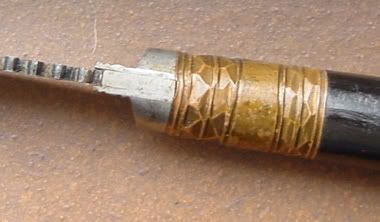
|
|
|

|
|
|
#2 |
|
Member
Join Date: Dec 2004
Location: What is still UK
Posts: 5,807
|
You can see my thinking here. The construction is fairly universal. the similarity may well be just that.
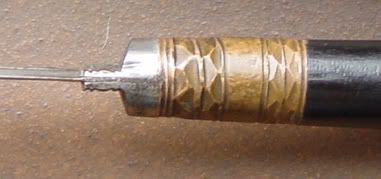  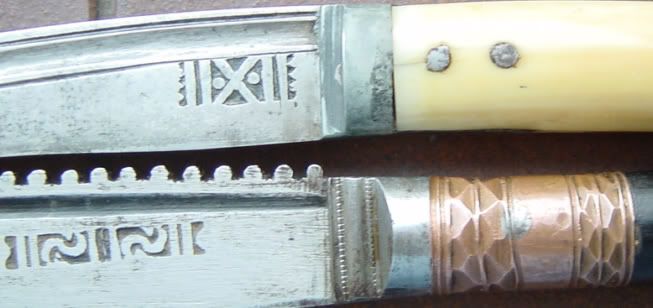 You can see that that the item in question has two rivets {the first rivet in the steel above the copper is clearly visible on the over side} like the Asian knife. The item in question also has a rivet through the copper part at the handle end. The African stylistic similarities,  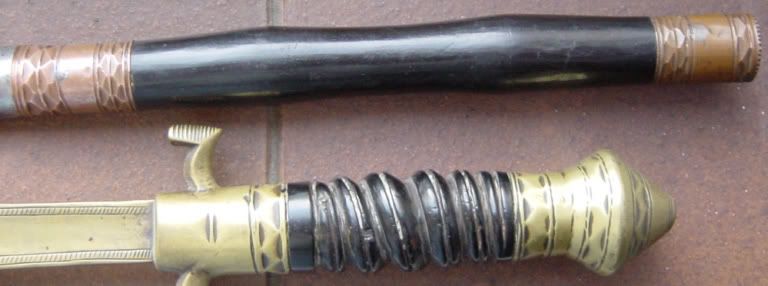  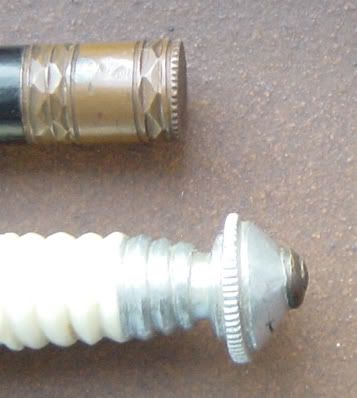 I could add more pictures if needed but I think you can get the idea? I need input on this. Thanks. Could it be seek and ye shall find? Last edited by Tim Simmons; 3rd October 2007 at 08:41 PM. |
|
|

|
|
|
#3 |
|
Member
Join Date: Dec 2004
Location: What is still UK
Posts: 5,807
|
Robert Edgerton mentions an 18" long razor in- Robert Edgerton, Warrior Women: The Amazons of Dahomey and the Nature of War (Westview Press, 2000. The weapon I post is 17" sadly I cannot obtian this book from amazon UK and it does not have a picture.
|
|
|

|
|
|
#4 |
|
Member
Join Date: Jan 2006
Location: Kent
Posts: 2,653
|
Hi Tim,
interesting item.......I must admit that my first impression is Asian. Is it possible that it could be a pole arm ( ceremonial or functional) that has been shortened ? When I researched the African short sword I acquired awhile ago ( it seemed likely Dahomney or neighbouring tribes.) I tried to discover common weapon forms of the area, I didn't find any reference to a weapon such as yours. I did read of references to a 'razor' but, from memory, I had the impression that this was a 'simple' blade which folded into a handle. (Sorry no pics) I'll try and find the description with the reference source. |
|
|

|
|
|
#5 |
|
Arms Historian
Join Date: Dec 2004
Location: Route 66
Posts: 9,957
|
Tim,
Nothing wrong with 'flights of fantasy'!  and with the unusual blade on this I can appreciate your inclination toward the somewhat distinct Dahomean blades found on the swords termed 'hwi'. It seems that one of these ceremonial weapons has similar crenallated blade back, but I cannot recall specifically and the reference is not at hand. It is shown in "Sabres Decores du Dahomey" (Palau Marti, 1967, but unfortunately cannot recall specific publication it appeared in, check bibliography in Spring for exact reference). and with the unusual blade on this I can appreciate your inclination toward the somewhat distinct Dahomean blades found on the swords termed 'hwi'. It seems that one of these ceremonial weapons has similar crenallated blade back, but I cannot recall specifically and the reference is not at hand. It is shown in "Sabres Decores du Dahomey" (Palau Marti, 1967, but unfortunately cannot recall specific publication it appeared in, check bibliography in Spring for exact reference). I recall the references to 'razors' in the book by Edgerton and some time ago was trying to determine more on this unusual weapons description as well. As you note the weapon in that book is listed as about 18", and I was also hoping for an illustration. Burton (Book of the Sword, 1884) discusses these on p.168-69 from his observations in his trip to Dahomey in 1863, noting the warrior king Gezo, his love of varities of unusual weapons, and of course "...a company of Amazons, called razor women from the 'nyek ple nen toh' blade. This was simply a European razor on a large scale, with a steel of 30" rising from a plain handle of black wood, and kept open by a spring". While the term 'nyek ple nen toh' is unclear in its exact meaning and is not defined in his copious footnotes, he does note that the reference to these weapons comes from his "Mission to Dahome" and is included with notes 'passim' along with other details. His comparison to a European razor of course held open by a spring with its huge size of 30" sounds questionable. His note sounds 'recollected' from notes some 19 years before, and I did not find evidence of such a collapsible weapon, but would look forward to hearing from anyone who knows of such a weapon in Africa. Since Gezo had such a fascination for unusual weapons and it sounds as if he was out to impress, it seems possible he may have created a number of such pieces in a ceremonial sense, but not necessarily for regular issue. I am inclined to agree with Katana in his Asian assessment on this piece, as you have also surmised. The long handle reminds me of the dha form, which I defer more on to the Dha Guys! and clearly the incised marking at the blade center corresponds well to the other example knife you have shown. I like the way you also present examples to show African similarities. Burton also notes the similarities in some weapons from India and Africa, suggesting that they may derive loosely from the same source weapons from Egypt, which of course is entirely plausible in a number of cases and in degree. I would like to hear more on the Asian potential on this interesting weapon, and look forward to information from that field. Thanks so much for sharing this piece......truly a great flight Tim!!!  All the best, Jim |
|
|

|
|
|
#6 |
|
Member
Join Date: Dec 2004
Location: What is still UK
Posts: 5,807
|
Jim I just do not know.
 Having it in my hand and the wood, there is just something African to me. I have come down to earth a little and have abandoned the Razor Women weapon but not the general West African area. The constuction only appears similar to the knife I have shown with it. It is quite different in reality. The similarities are after all fairly universal, a stamp on a blade is not rare nor is the bolster on the item. Just to illustrate this I will post pics of a Nigerian knife. It would be fantastic if some of the Asian collectors could show me the error of my ways. It is a nasty little slashing weapon, it is light only just 250g. I just do not know for sure, need help from Asian collectors please. Could be Chinese? |
|
|

|
|
|
#7 |
|
Arms Historian
Join Date: Dec 2004
Location: Route 66
Posts: 9,957
|
Me too Tim
 ! !I wish I had the Marti article to look through, or even the Spring book which has some good examples. It really is a tough call sometimes, the blade with these crenallations seems atypical for Asian weapons to me, but the grip aside from the widening center, still recalls the dha. We really do need some help from the dha guys! |
|
|

|
|
|
#8 |
|
Member
Join Date: Dec 2004
Location: What is still UK
Posts: 5,807
|
Only drawings so one has to assume great variety.
 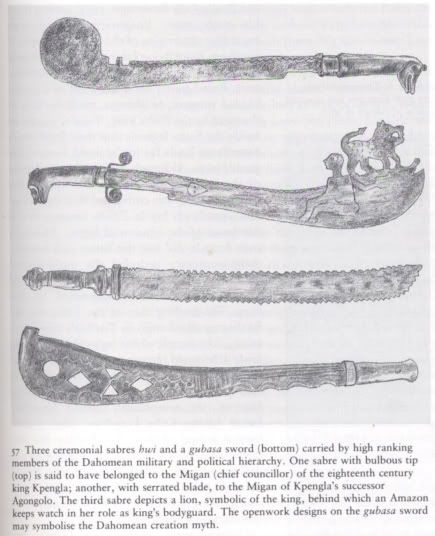
|
|
|

|
|
|
#9 |
|
Member
Join Date: Dec 2004
Location: What is still UK
Posts: 5,807
|
In the absents of Asian collectors opinions. I will just have to bravely soldier on, or is the silence telling?
I see the subtle shape to the handle as African and most of all the the loose and immediate ease of the triangle patterns on the copper also African. Perhaps Asian collectors can argue the same for Asian work. The handle is not as long as one would think. Look at the wood. Is it Asian?   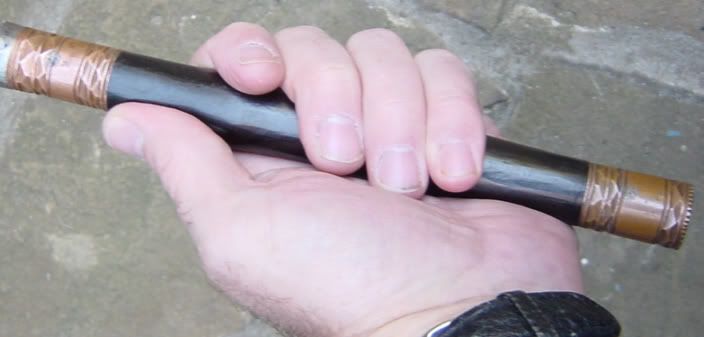 The Razor weapon may not be too much of a fantasy. |
|
|

|
|
|
#10 |
|
Arms Historian
Join Date: Dec 2004
Location: Route 66
Posts: 9,957
|
Excellent observations Tim, and very compelling. That wood seen along with the other items you show certainly seems strikingly similar, and as you suggest, quite African. Thank you so much for posting the Marti illustrations!
I could recall the very unusual shapes and presume the one with the barbs along the back triggered my thoughts on the crenallations on yours. Another thing you mentioned, as well as your very well placed thoughts on the loose geometric pattern on the hilt mounts, is the fact that they are copper. Isnt copperwork in material items key in certain African regions? I think west African if not mistaken. I doubt if the Asian collectors will read this unless we repost under another heading. |
|
|

|
|
|
#11 |
|
Member
Join Date: Dec 2004
Location: What is still UK
Posts: 5,807
|
Apparently there is Asian ebony. Indian {Ceylon} and East indian ebony {Malaysia}
I have seen Indian chillum in a black wood. I do not think this is Indian or that wood. I am puzzled on this one. The decoration just seems African. I just see Asian decoration as tight, formal or floral, more schematic? does that make sense? You could be right Jim. I will start a thread titled Asian Mak |
|
|

|
|
|
#12 |
|
Member
Join Date: Jul 2005
Location: Toronto, Canada
Posts: 1,242
|
Hi Tim, could this be a variant of Ram Dao or some sort of Naga Dao? The bolster looks very Nepalese to me.
|
|
|

|
|
|
#13 |
|
Member
Join Date: Dec 2004
Location: What is still UK
Posts: 5,807
|
I think you are right. Here-
http://www.trocadero.com/faganarms/i...tem424192.html It is somewhat light and short in the blade when I think of the few I have handled. The one in the link does have all the aspect of the one I have except the price luckily. Possibly, I have done rather well even if it is not what I wanted  It was not what I expected  To be a child of Kali, Ramprasad asserts, is to be denied of earthly delights and pleasures. Kali is said to not give what is expected. To the devotee, it is perhaps her very refusal to do so that enables her devotees to reflect on dimensions of themselves and of reality that go beyond the material world. Black for the black Goddess, see etymology- http://en.wikipedia.org/wiki/Kali http://en.wikipedia.org/wiki/Coromandel_Ebony Last edited by Tim Simmons; 5th October 2007 at 08:30 PM. |
|
|

|
|
|
#14 |
|
Member
Join Date: Nov 2004
Location: USA
Posts: 1,725
|
Hi Tim. I haven't been ignoring you on this one. I've been in trial and unable to spend much time on the forum or looking at my books.
I've never seen anything like this. It is quite beautiful. The blade profile, at least, does strike me as asian. However, I don't think it's a mak. Let me look at my sources a bit more. |
|
|

|
|
|
#15 |
|
Member
Join Date: Dec 2004
Location: What is still UK
Posts: 5,807
|
Thanks Andrew. I still have Africa in the back of my mind especially with reference to the decoration on the copper. I do not think it is a Mak this is not a chopper the blade is light with some flex. Look how similar the bolster is on this and the Ram dao in the link. The is also the similarities in the blade decoration the fuller topped by the crenellation. Googling Kali worship also puts quite a spin on it.
|
|
|

|
|
|
#16 |
|
Member
Join Date: Jan 2006
Location: Kent
Posts: 2,653
|
Stone shows a knife called a Bhuj Kutti, sometimes called an 'elephant knife' described as a heavy (?) single edged knife blade mounted inline with a single straight handle approx 20" long (not specified if OAL or just length of handle). The blade form illustrated is not the same, but there are similarities in the overall construction. I do not have a scanner so cant post the picture;
It is possible that yours is a varient, your pictures suggest that the knife is vintage rather than older, is this the case? |
|
|

|
|
|
#17 |
|
Arms Historian
Join Date: Dec 2004
Location: Route 66
Posts: 9,957
|
Nicely done observation on the ram dao Manolo! That was key!
Tim, I've really enjoyed this thread a lot because its been a genuine learning experience. I have never been especially keen on most Asian weapons due to express focus on other fields, but with this I have gained interest and insight toward them. Although this has proven to be other than what you anticipated, it seems to have opened new doors in my opinion, equally exciting. The best thing in this thread has been shared investigation and observation which is what I always hope for in these threads with unusual items! So getting back to that, now that the item in the catalog seems compellingly similar and identified as ram dao, on the issue of the copper which I noted as an important West African material. I think it is important to note the key use of brass and copper in Tantric votive items and material culture in Nepal and Tibet, and Im sure extensively elsewhere throughout the Buddhist sphere. It would be interesting to hear more on that from Rand, who is well versed on items from these regions. I think your observation on the black grips and association to Kali worship is also very interesting, and would like to learn more on that. All the best, Jim |
|
|

|
|
|
#18 |
|
Member
Join Date: Dec 2004
Location: What is still UK
Posts: 5,807
|
look at this thread again. I think I am right that this is African saying loud and proud. hallelujah James Brown

|
|
|

|
|
|
#19 |
|
Arms Historian
Join Date: Dec 2004
Location: Route 66
Posts: 9,957
|
OK Tim, whassup???

|
|
|

|
|
|
#20 |
|
Member
Join Date: Jan 2006
Location: Kent
Posts: 2,653
|
How about this....
KNIFE, INCISED DECORATION ASIAN ETHNOGRAPHIC COLLECTION Catalog No: 70.0/ 7766 Culture: INDIAN, KOTA Locale: NILGIRI HILLS Country: INDIA Material: METAL (STEEL), WOOD (KARPAMARU) Dimensions: L:40 W:11.4 H:4.2 [in CM] Donor: MANDELBAUM Accession No: 1938-57 |
|
|

|
|
|
#21 |
|
Member
Join Date: Jan 2006
Location: Kent
Posts: 2,653
|
Here is another 2 similar examples, smaller with a brass blade
KNIFE, DECORATED ASIAN ETHNOGRAPHIC COLLECTION Catalog No: 70.2/ 2050 Locale: BORNEO Material: METAL (BRASS) Dimensions: L:26 W:11 H:4 [in CM] Donor: BOULTON Accession No: 1951-84 KNIFE, DECORATED ASIAN ETHNOGRAPHIC COLLECTION Catalog No: 70.2/ 2051 Culture: KADAYAN ? Locale: BORNEO, BRUNEI ? Material: METAL (BRASS) Dimensions: L:27 W:14 H:4 [in CM] Donor: BOULTON Accession No: 1951-84 |
|
|

|
|
|
#22 |
|
Member
Join Date: Dec 2004
Location: What is still UK
Posts: 5,807
|
Well done David!!! Clearly the knife is Indian. Interestingly the group of aboriginal tribes of the Nilgiris hills the Kota being one of them, besides being the smiths and artisans and the lowest caste largely resisted Hinduism though I do have a book "The Aboriginal Tribes of India. Stephen Fuchs, pub- India 1973 Uk 1977" where it is said that they followed Shiva and other deities. They kept buffalo which were used in ceremonies and eaten. One might expect to find a knife like this for skinning. Skinning has been mentioned before. I can find no reference to blood cults or human sacrifice in the Nilgiris hill though I do not know about times past {these acts could be kept secret} but that is not so for Tamil Nadu and Southern India.
|
|
|

|
|
|
#23 |
|
Member
Join Date: Dec 2004
Location: What is still UK
Posts: 5,807
|
I am really wired up and going to blow all the fuses. I have just got back from walking the dogs and my mind was working over time. Can things just drop into place over time or do I need to be neutered and muzzled
 In the Nilgiris Hill when a buffalo is sacrificed it is done with a spear. I have always felt a purpose for this spear and assumed it was African by decoration as I did for this knife. I have not taken into consideration Indian aboriginal work. As mentioned the tribes in the Nilgiris hills may have incorporated Hindu thought into there own beliefs so the snake and Shiva, black and Kali could be displayed here. We know that brass and copper kept spiritual purity, perhaps all the more important with penetration. The killing and butchering of a buffalo still needing certain observances and implements. Is it possible that I have the spear and skinning knife? The damage to the blade not done by chopping but working around heavy bones. I will post pics of the people in question doing it in a funeral rite shortly.   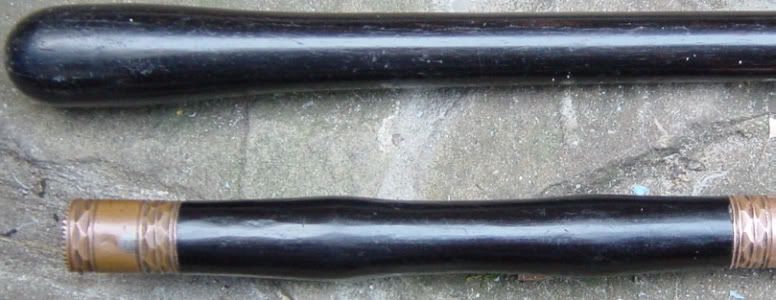
|
|
|

|
|
|
#24 |
|
Member
Join Date: Dec 2004
Location: What is still UK
Posts: 5,807
|
These pictures have the caption of Todas they are a related group to the Kota neither group are high in population the low thousands.
 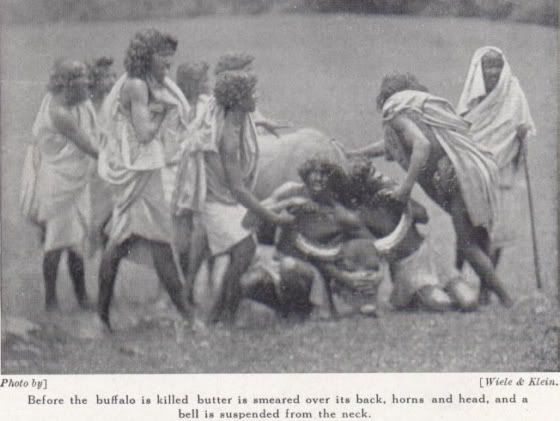 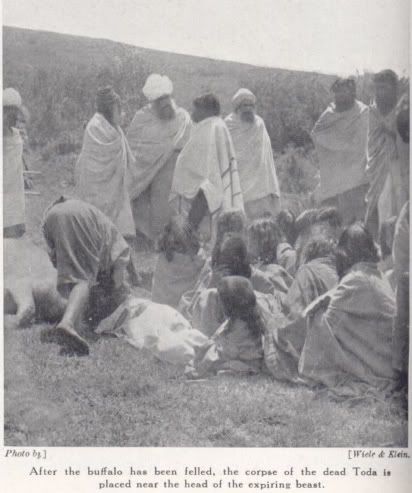
|
|
|

|
|
|
#25 |
|
Member
Join Date: Dec 2004
Location: What is still UK
Posts: 5,807
|
Look at this link-
http://www.svabhinava.org/friends/Fr...fice-frame.php It mentions that the Kota eat the meat. It also suggests that certainly with the Toda the buffalo is killed with an axe. The book I mention earlier states that the Kota killed the beast with a spear. The sequence of Toda pictures post earlier also back this up especially if you read the caption with the last picture. Last edited by Tim Simmons; 10th October 2007 at 09:28 PM. |
|
|

|
|
|
#26 |
|
(deceased)
Join Date: Dec 2004
Location: Portugal
Posts: 9,694
|
Hi David,
Good shot. Hi Tim, Does this mean Asia one Africa nil?  Fernando |
|
|

|
|
|
#27 |
|
Member
Join Date: Dec 2004
Location: What is still UK
Posts: 5,807
|
It is amazing what a snippet of information can do, the domino effect. This is what I call good value for money besides the knife being uncommon to say the least. I have had hours of fun thrashing it out and learnt more than I bargained for. To me the discovery makes sense, the spear and butchering knife made with spiritual cleansing in mind. I would like to thank all who contributed to my conversion. Especially David who shed light on the path. I look forward to the next esoteric flight. Thank you.

|
|
|

|
|
|
#28 | |
|
Member
Join Date: Jan 2006
Location: Kent
Posts: 2,653
|
Quote:
Your very welcome Tim   Regards David |
|
|
|

|
|
|
#29 |
|
Member
Join Date: Dec 2004
Location: Europe
Posts: 2,718
|
Anthony North: An Introduction to Islamic Arms, page 41 #39 d. Axe. Chiselled steel with brass mounts Indo-Persian 18/19th century. 82.3 cm.
|
|
|

|
|
|
#30 |
|
Member
Join Date: Dec 2004
Location: What is still UK
Posts: 5,807
|
Interesting shape comparison but as you can see it is not really an axe. The knife would work well for skinning and removing flesh from bones. I imagine bones would be defleshed whole and not chopped being a valuable material.
 
|
|
|

|
 |
|
|